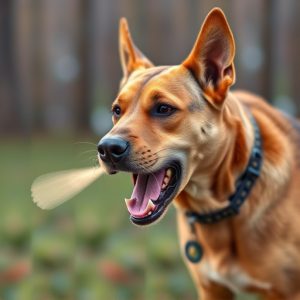Mace Spray for Animal Control: Airline Rules & Safety for Pet Defense
Mace spray, a non-lethal animal deterrent, is a safe and effective solution for pet owners facing wi…….
Mace spray, a non-lethal animal deterrent, is a safe and effective solution for pet owners facing wildlife intrusions or aggressive animals, particularly during airline travel. Adhering to Airline Rules for Pet Defense Spray ensures pets' well-being and avoids legal issues. Mace spray's active ingredient, oleoresin capsicum (OC), deters animals without causing harm. Proper usage involves understanding local rules, following manufacturer instructions, and prioritizing humane handling while targeting sensitive areas. As a last resort, there are growing trends towards humane, eco-friendly alternatives and behavior modifications, offering safer options for pet protection that align with evolving standards and regulations.
“Uncovering the power of mace spray as a non-lethal animal control solution, this article offers a comprehensive guide for pet owners. From understanding its effectiveness to navigating airline rules regarding pet defense sprays, we delve into the science and safety aspects. Learn how this deterrent works and explore alternative solutions for optimal pet protection. Ensure you’re prepared with the knowledge to make informed decisions, keeping your pets and family safe.”
- Understanding Mace Spray: A Non-Lethal Animal Deterrent
- Airline Rules and Pet Defense Spray: What You Need to Know
- The Science Behind its Effectiveness in Animal Control
- Application and Safety Precautions for Optimal Results
- Exploring Alternative Solutions: Beyond Mace Spray for Pet Protection
Understanding Mace Spray: A Non-Lethal Animal Deterrent
Mace spray, a non-lethal animal deterrent, has established itself as a powerful tool in pet defense and animal control. Unlike traditional methods that can cause harm or stress to animals, mace spray is designed to incapacitate temporarily without causing permanent damage. This makes it an ideal solution for homeowners facing unwanted wildlife intrusions or pet owners concerned about potential threats from aggressive animals.
In the context of airline rules regarding pet travel, mace spray serves as a crucial component in pet defense strategies. Many airlines permit the use of non-lethal deterrents like mace spray to protect both passengers and animals during transportation. This is particularly important for pets with behavioral issues or those prone to panic, ensuring their safety and comfort throughout the journey. Understanding the benefits and proper usage of mace spray can empower individuals to take control of pet defense, enhancing overall security and peace of mind.
Airline Rules and Pet Defense Spray: What You Need to Know
Airline travel can be a stressful experience, especially for pet owners who are concerned about their beloved animals’ safety and comfort during flight. When it comes to carrying pet defense sprays like mace spray for animal control, understanding airline rules is paramount. Many airlines have strict regulations regarding liquids and aerosols, including pet-related items, to ensure passenger safety and compliance with security standards.
Pet defense sprays designed for animal control are subject to these rules, often requiring them to meet specific size and packaging requirements. Travelers must check the airline’s policies well in advance, as restrictions vary. Some airlines allow small containers of pet defense spray as long as they meet the 100ml (3.4 oz) liquid limit per passenger and are packed in carry-on luggage. Others may only permit these sprays to be transported in checked baggage or not at all. Knowing and adhering to these Airline Rules for Pet Defense Spray is essential for a smooth travel experience, ensuring your pet’s safety without any legal issues.
The Science Behind its Effectiveness in Animal Control
The effectiveness of mace spray, specifically designed for animal control, stems from its active ingredient—oleoresin capsicum (OC). This natural compound, derived from chili peppers, has a powerful impact on an animal’s sensory system. When sprayed, OC irritates the eyes and respiratory tract, temporarily disorienting and deterring animals without causing significant harm.
In the context of airline rules regarding pet travel, mace spray for animal control plays a crucial role in pet defense. It offers a non-lethal solution for managing aggressive or frightened animals, ensuring the safety of passengers and crew. Many airlines permit the carriage of pet defense sprays as long as they meet specific criteria, such as size and compliance with airline-approved packaging. This allows travelers to have a means of self-defense against potentially dangerous animal encounters during their journey, aligning with overall pet safety measures.
Application and Safety Precautions for Optimal Results
When using mace spray for animal control, proper application is key to achieving optimal results. Start by ensuring you’re familiar with your local Airline Rules regarding pet defense sprays. Typically, these rules dictate storage and transportation guidelines to guarantee safety. Always follow the manufacturer’s instructions for usage, as different formulations may have specific application techniques. For best effectiveness, target areas like eyes, nostrils, and mouth, but be cautious not to aim towards sensitive human areas or the environment.
Safety precautions are paramount. Wear protective gear, including gloves and eye protection, to minimize direct contact with spray. Ensure adequate ventilation in the area to prevent inhalation of fumes. Keep mace spray out of reach of children and pets. In case of accidental exposure, have a wash station nearby for immediate decontamination. Remember, while powerful, mace spray should only be used as a last resort, and proper training is essential to handle animals humanely.
Exploring Alternative Solutions: Beyond Mace Spray for Pet Protection
In the quest for effective pet protection, it’s essential to explore a range of solutions beyond traditional mace spray, especially considering airline rules regarding pet defense sprays. While mace spray has been a go-to option for animal control, there are growing concerns about its impact on both pets and the environment. This prompts a shift towards more humane and eco-friendly alternatives that can still ensure the safety and well-being of our furry companions.
One such alternative is pet defense sprays specifically designed to deter potential threats without causing harm. These innovative products often utilize natural ingredients or capsicum-based formulas, which offer a safe yet effective way to protect pets during walks or in emergency situations. Additionally, many pet owners are opting for training methods and behavior modifications as primary preventive measures, further reducing the need for defensive sprays. By considering these alternatives, pet parents can make informed choices that align with their values while keeping their pets secure.
Mace spray, as a non-lethal animal deterrent, has proven its effectiveness in various scenarios, including airline travel and pet protection. However, it’s crucial to understand its application, safety precautions, and the growing interest in alternative solutions. By adhering to airline rules regarding pet defense spray and exploring broader strategies for pet safety, we can ensure humane and effective animal control while considering the well-being of both animals and humans.

